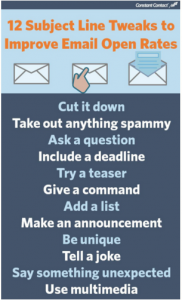When starting a new business, it is essential to have a strong brand that will stand out among competitors, especially when building relationships with new and current customers. E-mail marketing is a relatively low cost method of reaching customers directly with large potential outcomes. This platform will present your company values, decide how you communicate with your customers and build a repertoire to carry you as you build your company voice and image.
E-mail is also one of the fastest ways you can communicate with your customer base, but you need to do the right things to get your audience to open their emails! With such a high quantity of emails being sent out to subscribers every day, it’s important for you to gain their attention and then keep their interest. Key motives for opening emails include solving a problem, saving money, informing and entertaining customers (DJ, Waldow, 2013). Expressing one of these in your subject line can peak interest. Try to make your subject lines catchy, and if you are offering something, don’t appear too good to be true or a hard sell.
M. Paquet, 2015, also offers these subject line tips (see left hand side). When looking at my own emails it’s easy to see this pattern of traits. “Grab yourself 20% more miles! Final reminder, All you need is love… and our favourite products” etc etc etc!!! I thought it was really interesting that a few emails used my name in their subject line. This stood out more than others did as it’s rare to have such a personalisation in emails which you know have been sent to everyone. Even though a big corporation is sending mass emails, it has made you feel like you have a relationship with them, however small. D.Moth et al also has personalisation as their top email marketing trend set to dominate 2016. This builds on segmented campaigns to manage a more one-to-one experience.
The time of day also effects opening rates a lot too. An analysis of 21 million emails from GetResponse in 2012 showed that “24% of all emails are opened within the first hour; that number drops off precipitously as the hours tick by. The best time to send emails is when customers are reviewing their inboxes; morning and early afternoon” (M.Sebastian, 2012). During a talk on the subject, my lecturer discussed how he and a co-worker were subscribed to the same email, yet received them at different times of the day depending on their past email opening habits. This is another extension of how you can personalise your emails to suit your customers. Just make sure you don’t assume anything too specific about your customers as that could have the opposite effect and put them off if you were wrong about their wants and needs.
Once you have perfected you hook, line and sinker of a subject line, your email image, layout and content need to represent your business while keeping your customer relationship how you want it. Key factors include length of email, branding, and call-to-actions. Length is something you should test out to see how your customers respond. Generally, “If it’s promotional it will be short, but if it’s a newsletter it will be longer,” according to Ellis-Chadwick and Doherty. This was one of their many findings when examining a range of elements in a sample of permission-based e-mail marketing campaigns. The study also stresses the importance of the top of your email, particularly the left corner where 99% of emails exhibited their brand logo. You need to show your best self at the top because customers will have to engage if you want them to scroll. You also need to take into consideration how your email will preview on different devices, and which majority demographic you will cater your coding to suit.
Call-to-actions need to be used carefully. Too many can be overwhelming and put customers off, too few and customers could be frustrated at not getting what they wanted from your email. Every link needs to have a specific landing page directly related to where you want your customer to go. There is nothing worse than seeing exactly what you want in an email and then having to hunt through a website to find it again. Bonini states how important positioning, landing page correlation and value offered are when creating your CTA’s. If your CTA doesn’t convey value too your customer it will be wasted space. A good method is to strategically place them in related text that you know your customer is interested in.
Now that you have considered all of this, it’s a good idea to have a full plan ready for your next campaign. This can be made easier with customisable email templates, setting your emails specific goals to reach and keeping on top of your organisation! After each email sent, you can learn and improve on the next one while your communications grow. You should always want to build your customer relationships so this process will be important at all times.
References:
DJ, Waldow, 2013 http://www.entrepreneur.com/article/226221
M. Paquet, 2015 http://blogs.constantcontact.com/good-email-subject-lines/#
D.Moth et al 2015 https://econsultancy.com/blog/67358-nine-email-marketing-trends-set-to-dominate-2016/
M.Sebastian, 2012 http://www.entrepreneur.com/article/225266
Ellis-Chadwick & Doherty, 2012 http://www.sciencedirect.com.ezproxy.brighton.ac.uk/science/article/pii/S0148296311000063
J. Bonini, 2016 https://www.impactbnd.com/blog/design-tips-for-creating-calls-to-action-that-pop-off-the-page
Top image from https://www.campaignmonitor.com/best-email-marketing-campaigns/
word count: 841

